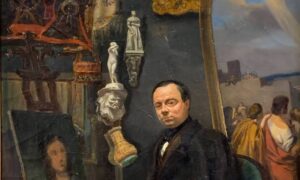
Masterpieces of Imagination: The Visionary Art of Louis Joseph César Ducornet Form 1220 AH TO 1272 AH
Alex
- 0
Table of Contents
ToggleExploring the Life and Legacy of a 19th Century Artistic Genius
Louis Joseph César Ducornet, a name that may not echo through the halls of mainstream art history as prominently as some of his contemporaries, remains a figure of significant interest for art enthusiasts and scholars alike. His works offer a glimpse into the artistic and cultural milieu of the 19th century, characterized by a unique blend of romanticism, realism, and innovative techniques. In this article, we will delve into Ducornet’s life, artistic style, major works, and lasting impact on the art world.
Early Life and Influences
Born in 1820 in the picturesque town of Strasbourg, Ducornet grew up amidst the rich cultural backdrop of Alsace, a region known for its artistic heritage. His early exposure to the arts was profoundly influenced by the picturesque landscapes and vibrant traditions of his homeland. His family, recognizing his talent, encouraged his artistic pursuits, leading him to study at the prestigious École des Beaux-Arts in Paris.
Ducornet’s formative years coincided with a period of intense artistic evolution in France. The rise of romanticism and the later emergence of realism provided a dynamic context in which Ducornet developed his style. He was particularly influenced by the works of artists such as Eugène Delacroix and Gustave Courbet, whose explorations of emotion and nature resonated with him. Ducornet’s ability to synthesize these influences into his own distinctive voice would set the stage for his future success.
The Artistic Journey
Ducornet’s artistic journey began in earnest during the 1840s, a decade marked by significant experimentation and innovation. His early works were primarily characterized by romantic themes, showcasing lush landscapes and dramatic compositions that captured the viewer’s imagination. His use of color and light reflected the emotive qualities of the romantic movement, while his attention to detail demonstrated a deep respect for nature.
One of Ducornet’s most notable early works, “The Stormy Sea,” exemplifies his ability to evoke emotion through natural elements. The painting depicts tumultuous waves crashing against jagged rocks, with dark clouds looming overhead. This dramatic scene captures the viewer’s attention, drawing them into the tempestuous energy of the moment. Critics praised Ducornet for his skillful rendering of light and shadow, which added depth and intensity to his compositions.
Transition to Realism
As the 1850s approached, Ducornet began to shift his focus from romanticism to realism. This transition was marked by a desire to depict the world as it truly was, rather than how it was imagined. Ducornet’s commitment to realism allowed him to explore themes of everyday life, social issues, and the human condition. His works began to reflect a more profound engagement with contemporary society, as he sought to portray the struggles and triumphs of ordinary people.
One of his most celebrated realist works, “The Harvesters,” captures the essence of rural life in 19th-century France. The painting portrays a group of laborers engaged in the backbreaking work of harvesting crops under the warm glow of the sun. Ducornet’s meticulous attention to detail, from the texture of the wheat to the expressions of the workers, conveys a sense of authenticity that resonates with viewers. This piece exemplifies his ability to elevate mundane subjects into powerful statements about the human experience.
A Distinctive Style
Ducornet’s artistic style is characterized by a unique fusion of romanticism and realism, marked by a keen sense of observation and an emotional depth that draws viewers into his world. His use of color is particularly noteworthy, as he employed a rich palette to create atmospheric effects that heightened the emotional impact of his works. His brushwork ranged from delicate and refined to bold and expressive, allowing him to convey a wide array of emotions.
In addition to his mastery of color, Ducornet was also adept at composition. He often employed dynamic arrangements that guided the viewer’s eye through the painting, creating a sense of movement and narrative. This compositional skill is evident in works such as “The Return from the Market,” where figures are strategically placed to create a harmonious balance between foreground and background, inviting viewers to engage with the story unfolding within the canvas.
Major Works and Exhibitions
Throughout his career, Ducornet produced a substantial body of work, with many pieces exhibited at prestigious salons and galleries. His contributions to the Salon de Paris garnered significant attention, earning him recognition among his peers and collectors alike. Some of his major works include:
- “The Fisherman’s Daughter”: This painting showcases a young girl sitting by the river, lost in thought as she gazes at the water. The serene expression on her face, combined with the gentle ripples of the water, creates a contemplative mood that resonates with viewers.
- “Rural Festival”: Capturing the vibrancy of rural life, this work depicts a lively celebration with villagers dancing and enjoying the festivities. The colorful costumes and joyful expressions of the participants convey a sense of community and joy, reflecting Ducornet’s fascination with social interactions.
- “The Gleaners”: In this poignant piece, Ducornet portrays a group of women gathering leftover grain after the harvest. The painting serves as a commentary on the struggles of the lower classes, highlighting their resilience in the face of adversity.
Ducornet’s ability to tackle social themes while maintaining a strong emotional core is what set him apart from many of his contemporaries. His works not only captured the beauty of the world around him but also delved into the complexities of human experience.
Detailed Analysis of Key Works
To fully appreciate Ducornet’s artistic legacy, it is essential to delve deeper into some of his key works. Each painting not only showcases his technical skills but also reflects the socio-political context of his time.
“The Stormy Sea”
In “The Stormy Sea,” Ducornet creates a visceral representation of nature’s fury. The tumultuous waves are depicted with dynamic brushstrokes that convey movement and chaos. The dark clouds overhead, painted in shades of gray and blue, enhance the sense of impending danger. This work not only reflects Ducornet’s skill in capturing atmospheric effects but also serves as a metaphor for the struggles of life itself.
“The Harvesters”
This painting, often celebrated for its social commentary, provides a window into the harsh realities of rural life. Ducornet’s depiction of laborers at work is imbued with dignity and respect. The golden hues of the wheat fields contrast sharply with the dark earth, creating a striking visual balance. The expressions of the workers, a mix of concentration and exhaustion, capture the physical toll of their labor. This work invites viewers to empathize with the plight of the working class, a theme that resonated deeply during Ducornet’s time.
“Rural Festival”
In “Rural Festival,” Ducornet employs vibrant colors and lively compositions to depict a scene of communal joy. The dancers, adorned in colorful traditional attire, are captured mid-motion, their expressions radiating happiness and vitality. The background, filled with trees and distant hills, grounds the scene in a specific cultural context. This work highlights the importance of community and celebration, emphasizing the joys of rural life amidst the struggles of everyday existence.
Thematic Exploration in Ducornet’s Works
Ducornet’s oeuvre is marked by several recurring themes that reflect the complexities of 19th-century society. His exploration of social issues, emotional depth, and connection to nature resonates throughout his body of work.
Social Commentary
A significant aspect of Ducornet’s art is its social commentary. Many of his paintings address the struggles of the working class, portraying their lives with empathy and dignity. Works like “The Gleaners” exemplify this theme, highlighting the resilience and perseverance of individuals facing economic hardship. By focusing on the human experience, Ducornet elevates his subjects beyond mere representation, encouraging viewers to engage with the social realities of their time.
Connection to Nature
Nature plays a pivotal role in Ducornet’s work, often serving as both a backdrop and a character in its own right. His landscapes are not merely settings but integral components of the emotional narrative. The beauty and ferocity of nature are depicted with equal reverence, reflecting the Romantic ideal of nature as a source of inspiration and contemplation. This connection to nature also aligns with the broader cultural movements of the time, which celebrated the natural world as a counterpoint to industrialization and urbanization.
Emotional Depth
Ducornet’s ability to convey emotion is one of his most distinctive qualities. Whether depicting the joy of a festival or the toil of laborers, his works evoke a strong emotional response from viewers. This emotional depth is achieved through his use of color, composition, and expressive figures. Each painting tells a story, inviting viewers to connect with the human experiences portrayed on canvas.
The Artistic Community and Influences
Ducornet’s career unfolded within a vibrant artistic community in 19th-century France. The interplay between artists, critics, and the public shaped the evolution of his style and the reception of his work. Understanding this context is crucial to appreciating Ducornet’s contributions to the art world.
The Salon System
The Salon de Paris was the premier exhibition space for artists in France during the 19th century. Ducornet’s participation in this annual event was instrumental in establishing his reputation. The Salon provided a platform for artists to showcase their work, and its influence on public taste and artistic trends cannot be overstated.
Ducornet’s early submissions were met with positive reviews, propelling him into the spotlight. His ability to adapt to changing artistic trends, while maintaining his unique voice, allowed him to navigate the competitive landscape of the art world. The Salon also served as a hub for networking, enabling Ducornet to connect with other artists, patrons, and critics.
Influences from Contemporaries
Ducornet’s artistic development was shaped by his interactions with other notable artists of the time. The works of Eugène Delacroix and Gustave Courbet, among others, had a profound impact on his approach to color, composition, and subject matter. Delacroix’s emotive use of color and dramatic compositions influenced Ducornet’s early romantic works, while Courbet’s commitment to realism inspired his later explorations of everyday life.
Moreover, Ducornet’s engagement with the broader cultural movements of the time, such as the Romantic and Realist movements, allowed him to situate his work within a larger artistic dialogue. This interplay of influences enriched his artistic practice, enabling him to innovate while remaining connected to the traditions that shaped his early development.
The Reception of Ducornet’s Work
Ducornet’s work received varying degrees of recognition throughout his career. While he achieved success at the Salon and garnered praise from critics, his fame did not reach the heights of some of his contemporaries. However, this relative obscurity in the broader art historical narrative has allowed for a reevaluation of his contributions in recent years.
Critical Reception
During his lifetime, Ducornet was praised for his technical skills and emotional depth. Critics noted his ability to evoke a sense of atmosphere and his keen eye for detail. His transition from romanticism to realism was met with admiration, as reviewers recognized his commitment to portraying the human experience authentically.
However, as art movements evolved, Ducornet’s work became overshadowed by the rise of Impressionism and Post-Impressionism. These newer movements, characterized by their focus on light and color, shifted public interest away from the themes that had defined Ducornet’s oeuvre. Consequently, his work fell into relative obscurity, leading to a diminished presence in art history.
Reevaluation and Rediscovery
In recent decades, art historians and curators have begun to reevaluate Ducornet’s contributions to the 19th-century art scene. Exhibitions dedicated to his work and scholarly publications have sought to highlight his unique voice and artistic innovations. This renewed interest has positioned Ducornet as a pivotal figure in the transition between romanticism and realism, illuminating his relevance within the broader context of art history.
Ducornet’s Techniques and Innovations
Ducornet’s artistic practice was marked by a dedication to technique and innovation. His approach to painting, characterized by meticulous attention to detail and a willingness to experiment with form and color, set him apart from his contemporaries.
Use of Color
Color played a central role in Ducornet’s work, serving as a means of conveying emotion and atmosphere. His palette was rich and varied, allowing him to create nuanced compositions that resonated with viewers. Ducornet’s ability to blend colors seamlessly, coupled with his understanding of light and shadow, enabled him to create depth and dimension in his paintings.
In works like “The Harvesters,” the interplay of warm golden tones against cooler earth tones creates a dynamic visual experience. This mastery of color not only enhances the emotional impact of his paintings but also demonstrates his keen observational skills.
Innovative Composition
Ducornet’s compositions are marked by a sense of balance and harmony. He often employed techniques such as leading lines and diagonal arrangements to guide the viewer’s eye through the painting. This dynamic approach to composition creates a sense of movement and invites viewers to engage with the narrative unfolding within the canvas.
In “Rural Festival,” for example, the arrangement of figures in a circular formation draws the viewer’s attention to the central action of the celebration. The careful placement of elements within the frame creates a cohesive composition that enhances the overall impact of the work.
Conclusion
Louis Joseph César Ducornet may not be a household name, but his artistic legacy is one that deserves recognition and celebration. Through his masterful blend of romanticism and realism, he captured the essence of the human experience, inviting viewers to reflect on the world around them. His commitment to portraying the struggles and triumphs of ordinary life has left an indelible mark on the art world, inspiring future generations of artists to explore the depths of emotion and the richness of human experience.
As we revisit Ducornet’s works, we are reminded of the power of art to transcend time and connect us to our shared humanity. His paintings, imbued with emotion and insight, continue to resonate with audiences today, ensuring that his legacy endures for years to come. Louis Joseph César Ducornet’s journey through the artistic landscape of the 19th century remains a testament to the enduring power of creativity and imagination.
Further Reflections on Ducornet’s Influence
In the contemporary art world, Ducornet’s influence can be seen in the works of modern artists who explore similar themes of social justice, human resilience, and the beauty of nature. His ability to engage with pressing social issues while maintaining an emotional core has paved the way for artists seeking to create meaningful narratives in their work.
Moreover, the rise of environmental art in recent years has echoed Ducornet’s profound connection to nature. As contemporary artists grapple with themes of ecological crisis and environmental sustainability, Ducornet’s appreciation for the natural world serves as a reminder of the importance of nurturing our relationship with the environment.
Legacy in Modern Art Education
Ducornet’s contributions extend beyond the canvas. His artistic journey serves as a valuable case study in art education, offering insights into the evolution of artistic styles and the interplay between societal context and artistic expression.
Art students and scholars today can learn from Ducornet’s commitment to his craft, his willingness to evolve as an artist, and his ability to navigate the complex landscape of 19th-century art. His work encourages aspiring artists to engage with their own cultural contexts, explore the depths of human emotion, and remain open to experimentation.
The Future of Ducornet’s Recognition
As art institutions continue to reevaluate the narratives surrounding 19th-century artists, Ducornet’s legacy stands to benefit from a broader understanding of the diverse voices that contributed to this vibrant period in art history.
Future exhibitions, publications, and academic studies will undoubtedly play a crucial role in solidifying Ducornet’s place within the canon of art history. The ongoing efforts to celebrate underrepresented artists serve not only to honor their contributions but also to enrich our understanding of the multifaceted nature of artistic expression.
In conclusion, Louis Joseph César Ducornet’s remarkable journey through the artistic landscape of the 19th century serves as a testament to the enduring power of creativity, imagination, and the human spirit. His legacy, now being rediscovered, continues to inspire artists and art lovers alike, ensuring that his vision and artistry will resonate for generations to come. For more information please visit techwebme.com

